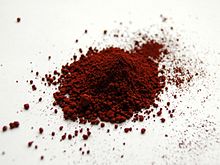


Inchemistry, iron(III)orferric refers to the element iron in its +3 oxidation state. Ferric chloride is an alternative name for iron(III) chloride (FeCl3). The adjective ferrous is used instead for iron(II) salts, containing the cation Fe2+. The word ferric is derived from the Latin word ferrum, meaning "iron".
Although often abbreviated as Fe3+, that naked ion does not exist except under extreme conditions. Iron(III) centres are found in many compounds and coordination complexes, where Fe(III) is bonded to several ligands. A molecular ferric complex is the anion ferrioxalate, [Fe(C2O4)3]3−, with three bidentate oxalate ions surrounding the Fe core. Relative to lower oxidation states, ferric is less common in organoiron chemistry, but the ferrocenium cation [Fe(C2H5)2]+ is well known.
All known forms of life require iron, which usually exists in Fe(II) or Fe(III) oxidation states.[1] Many proteins in living beings contain iron(III) centers. Examples of such metalloproteins include oxyhemoglobin, ferredoxin, and the cytochromes. Many organisms, from bacteria to humans, store iron as microscopic crystals (3 to 8 nm in diameter) of iron(III) oxide hydroxide, inside a shell of the protein ferritin, from which it can be recovered as needed. [2]
Insufficient iron in the human diet causes anemia. Animals and humans can obtain the necessary iron from foods that contain it in assimilable form, such as meat. Other organisms must obtain their iron from the environment. However, iron tends to form highly insoluble iron(III) oxides/hydroxides in aerobic (oxygenated) environment, especially in calcareous soils. Bacteria and grasses can thrive in such environments by secreting compounds called siderophores that form soluble complexes with iron(III), that can be reabsorbed into the cell. (The other plants instead encourage the growth around their roots of certain bacteria that reduce iron(III) to the more soluble iron(II).)[3]
The insolubility of iron(III) compounds is also responsible for the low levels of iron in seawater, which is often the limiting factor for the growth of the microscopic plants (phytoplankton) that are the basis of the marine food web.[4]

Typically iron(III) salts, like the "chloride" are aquo complexes with the formulas [Fe(H2O)5Cl]2+, [Fe(H2O)4Cl2]+, and [Fe(H2O)3Cl3]. Iron(III) nitrate dissolved in water to give [Fe(H2O)6]3+ ions. In these complexes, the protons are acidic. Eventually these solutions hydrolyze producing iron(III) hydroxide Fe(OH)3 that further converts to polymeric oxide-hydroxide via the process called olation. These hydroxides precipitates out of the solution as solids. That reaction liberates hydrogen ions H+ lowering the pH of its solutions. The equilibria are elaborate:[5]
Various chelating compounds prevent the polymerization. These same ligands can even dissolve iron(III) oxides and hydroxides. One of these ligands is EDTA, which is often used to dissolve iron deposits or added to fertilizers to make iron in the soil available (soluble) to plants. Citrate also solubilizes ferric ion at neutral pH, although its complexes are less stable than those of EDTA. Many chelating ligands - the siderophores - are produced naturally to dissolve iron(III) oxides.
The aquo ligands on iron(III) complexes are labile. This behavior is visualized by the color change brought about by reaction with thiocyanate:
Whereas [Fe(H2O)6]3+ is nearly colorless, [Fe(SCN)(H2O)5]2+ is deep red.
While iron(III) aquo complexes tend to convert to polymeric oxy-hydroxides, iron(III) complexes with other ligands form stable solutions. The complex with 1,10-phenanthrolinebipyridine is soluble and can sustain reduction to it iron(II) derivative:


Iron(III) is found in many minerals and solids, e.g., oxide Fe2O3 (hematite) and iron(III) oxide-hydroxide FeO(OH) are extremely insoluble reflecting their polymeric structure. Rust is a mixture of iron(III) oxide and oxide-hydroxide that usually forms when iron metal is exposed to humid air. Unlike the passivating oxide layers that are formed by other metals, like chromium and aluminum, rust flakes off, because it is bulkier than the metal that formed it. Therefore, unprotected iron objects will in time be completely turned into rust.

Iron(III) is a d5 center, meaning that the metal has five "valence" electrons in the 3d orbital shell. The number and type of ligands bound to iron(III) determine how these electrons arrange themselves. With so-called "strong field ligands" such as cyanide, the five electrons pair up as best they can. Thus ferricyanide ([Fe(CN)6]3− has only one unpaired electron. It is low-spin. With so-called "weak field ligands" such as water, the five electrons are unpaired. Thus aquo complex ([Fe(H2O)6]3+ has only five unpaired electrons. It is high-spin. With chloride, iron(III) forms tetrahedral complexes, e.g. ([Fe(Cl)4]−. Tetrahedral complexes are high spin. The magnetism of ferric complexes can show when they are high or low spin.